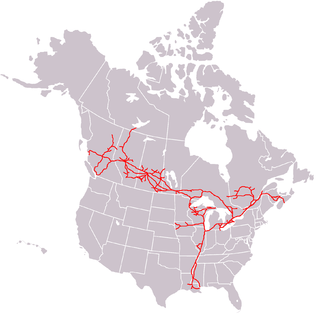
The Canadian National Railway Company is a Canadian Class I freight railway headquartered in Montreal, Quebec, which serves Canada and the Midwestern and Southern United States.

The Grand Trunk Western Railroad Company is an American subsidiary of the Canadian National Railway operating in Michigan, Illinois, Indiana, and Ohio. Since a corporate restructuring in 1971, the railroad has been under CN's subsidiary holding company, the Grand Trunk Corporation. Grand Trunk Western's routes are part of CN's Michigan Division. Its primary mainline between Chicago and Port Huron, Michigan serves as a connection between railroad interchanges in Chicago and rail lines in eastern Canada and the Northeastern United States. The railroad's extensive trackage in Detroit and across southern Michigan has made it an essential link for the automotive industry as a hauler of parts and automobiles from manufacturing plants.

The Mount Hood Railroad is a heritage and shortline freight railroad located in Hood River, Oregon, 60 miles (97 km) east of Portland, Oregon, United States.
The Lake Superior and Ishpeming Railroad, is a U.S. railroad offering service from Marquette, Michigan, to nearby locations in Michigan's Upper Peninsula. It began operations in 1896. The LS&I continues to operate as an independent railroad from its headquarters in Marquette.

The Detroit and Toledo Shore Line Railroad is a historic railroad that operated in northwestern Ohio and southeastern Michigan.
This is a list of jargon commonly used by railfans and railway employees in New Zealand.

The Midland line is a 212 km section of railway between Rolleston and Greymouth in the South Island of New Zealand. The line features five major bridges, five viaducts and 17 tunnels, the longest of which is the Otira tunnel. It is the route of the popular TranzAlpine passenger train.
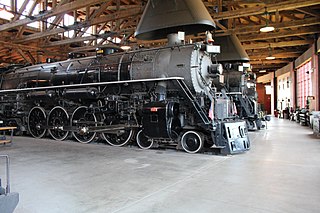
Grand Trunk Western No. 6325 is a class "U-3-b" 4-8-4 "Northern" type steam locomotive built in 1942 by the American Locomotive Company (ALCO) for the Grand Trunk Western Railroad. As a member of the dual service U-3-b class, the 6325 handled heavy passenger and freight work for the Grand Trunk Western. In 1946, the 6325 gained notoriety for pulling United States President Harry S. Truman's election campaign train through the state of Michigan. Retired in 1959, the locomotive was donated for display to the City of Battle Creek, Michigan where a failed restoration attempt left 6325 in danger of being scrapped. Purchased in 1993 by Jerry Jacobson of the Ohio Central Railroad, the locomotive sat in storage for six years until being restored to operating condition on July 31, 2001, for use on excursion trains across the Ohio Central System. The locomotive is in storage, on static display at the Age of Steam Roundhouse in Sugarcreek, Ohio.

The USRA Light Pacific was a USRA standard class of steam locomotive designed under the control of the United States Railroad Administration, the nationalized railroad system in the United States during World War I. This was the standard light passenger locomotive of the USRA types with a 4-6-2 wheel arrangement in the Whyte notation, or 2′C1′ in UIC classification.
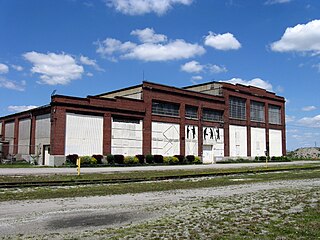
The Elgin County Railway Museum is a rail transport museum in St. Thomas, Ontario.
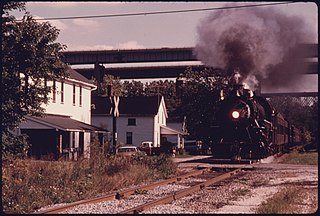
Grand Trunk Western No. 4070 is a class "S-3-a" 2-8-2 type USRA Light Mikado steam locomotive originally built by the American Locomotive Company (ALCO) in December 1918 for the Grand Trunk as No. 474, later re-numbered by Grand Trunk Western Railroad, after the GT was absorbed into Canadian National as GTW No. 3734. In the late 1950s the locomotive was given a larger tender, from an S-3-c, and re-numbered 4070. The locomotive has pulled passenger excursions in Illinois, Indiana, Ohio and Pennsylvania over the years.

Grand Trunk Western No. 6039 is a preserved class "U-1-c" 4-8-2 "Mountain type" steam locomotive built in June 1925 by Baldwin. It served the Grand Trunk Western Railroad by pulling fast passenger and freight trains throughout the Lower Peninsula of Michigan, until the railroad decided to dieselize their locomotive fleet. During that time, it was leased to the Central Vermont Railway for freight service, only to become one of the very last steam locomotives to regularly operate in the state of Vermont. After being retired in the late 1950s, No. 6039 became one of the very first steam locomotives to be owned by F. Nelson Blount, and it subsequently became part of his Steamtown, U.S.A. collection for static display. In 1984, the locomotive was moved along with every other locomotive in the Steamtown collection from Bellows Falls to Scranton, Pennsylvania, where the name would late be changed to Steamtown National Historic Site under the jurisdiction of the National Park Service. As of 2022, No. 6039 remains on static display at Scranton with very meticulous cosmetic care.

Grand Trunk Western No. 6323 is a preserved class "U-3-b" 4-8-4 "Northern" type steam locomotive built by Alco in 1942. It served the Grand Trunk Western Railroad by pulling various heavy freight and passenger trains across the Lower Peninsula of Michigan and Northern Indiana. It became famous in later years for being the very last active steam locomotive to run on the GTW's trackage while still on the railroad's active list in 1961. After sitting in storage for several years in Detroit, No. 6323 was sold in 1981 to the Illinois Railway Museum, and since then, it has remained on static display in Union, Illinois.
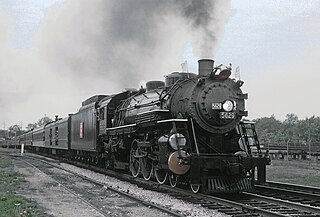
Grand Trunk Western 5629 was a 4-6-2 K-4a steam locomotive built by American Locomotive Company (ALCO) in 1924, for the Grand Trunk Western Railroad. It was a copy of the USRA Light Pacific locomotives. It became famous after being purchased by Richard Jensen for use in pulling several excursion trains in the Chicago area throughout the 1960s. After Jensen ran into some financial trouble, No. 5629 was put into storage at the Rock Island Railroad's Blue Island, Illinois freight yard. No. 5629 was subsequently the subject to a legal battle between Jensen and Metra Commuter Rail in the mid-1980s, and it ultimately led to the locomotive's scrapping in July 1987.













